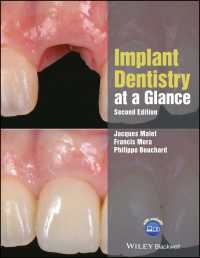Description
A comprehensive introduction to the role of epidemiology in veterinary medicine
This fully revised and expanded edition of Veterinary Epidemiology introduces readers to the field of veterinary epidemiology. The new edition also adds new chapters on the design of observational studies, validity in epidemiological studies, systematic reviews, and statistical modelling, to deliver more advanced material.
This updated edition begins by offering an historical perspective on the development of veterinary medicine. It then addresses the full scope of epidemiology, with chapters covering causality, disease occurrence, determinants, disease patterns, disease ecology, and much more.
Veterinary Epidemiology, Fourth Edition:
● Features updates of all chapters to provide a current resource on the subject of veterinary epidemiology
● Presents new chapters essential to the continued advancement of the field
● Includes examples from companion animal, livestock, and avian medicine, as well as aquatic animal diseases
● Focuses on the principles and concepts of epidemiology, surveillance, and diagnostic-test validation and performance
● Includes access to a companion website providing multiple choice questions
Veterinary Epidemiology is an invaluable reference for veterinary general practitioners, government veterinarians, agricultural economists, and members of other disciplines interested in animal disease. It is also essential reading for epidemiology students at both the undergraduate and postgraduate levels.
Table of Contents
Contributors xviii
From the preface to the first edition xix
From the preface to the second edition xx
From the preface to the third edition xxi
Preface to the fourth edition xxii
About the companion website xxiv
1 The development of veterinary medicine 1
Michael Thrusfield
Historical perspective 1
Domestication of animals and early methods of healing 1
Changing concepts of the cause of disease 2
Impetus for change 5
Quantification in medicine 10
Contemporary veterinary medicine 12
Current perspectives 12
The fifth period 19
Recent trends 20
Further reading 25
2 The scope of epidemiology 28
Michael Thrusfield
Definition of epidemiology 28
The uses of epidemiology 29
Types of epidemiological investigation 32
Epidemiological subdisciplines 33
Components of epidemiology 35
Qualitative investigations 35
Quantitative investigations 36
Epidemiology’s locale 39
The interplay between epidemiology and other sciences 39
The relationship between epidemiology and other diagnostic disciplines 40
Epidemiology within the veterinary profession 40
Further reading 41
3 Causality 42
Michael Thrusfield
Philosophical background 42
Causal inference 43
Methods of acceptance of hypotheses 44
Koch’s postulates 45
Evans’ rules 45
Variables 46
Types of association 46
Non-statistical association 46
Statistical association 46
Confounding 49
Causal models 50
Formulating a causal hypothesis 53
Methods of deriving a hypothesis 53
Principles for establishing cause: Hill’s criteria 55
Further reading 56
4 Describing disease occurrence 58
Michael Thrusfield
Some basic terms 58
Basic concepts of disease quantification 61
The structure of animal populations 62
Contiguous populations 62
Separated populations 65
Measures of disease occurrence 67
Prevalence 67
Incidence 67
The relationship between prevalence and incidence rate 70
Application of prevalence and incidence values 72
Mortality 72
Survival 73
Example of calculation of prevalence, incidence, mortality, case fatality and survival 75
Ratios, proportions and rates 76
Mapping 80
Geographic base maps 80
Further reading 84
5 Determinants of disease 86
Michael Thrusfield
Classification of determinants 86
Host determinants 89
Genotype 89
Age 90
Sex 91
Species and breed 92
Behaviour 93
Other host determinants 93
Agent determinants 94
Virulence and pathogenicity 94
Gradient of infection 97
Outcome of infection 98
Microbial colonization of hosts 100
Environmental determinants 101
Location 101
Climate 101
Husbandry 104
Stress 105
Interaction 106
Biological interaction 108
Statistical interaction 109
The cause of cancer 110
Further reading 112
6 The transmission and maintenance of infection 115
Michael Thrusfield
Horizontal transmission 115
Types of host and vector 115
Factors associated with the spread of infection 118
Routes of infection 121
Methods of transmission 123
Long-distance transmission of infection 125
Vertical transmission 129
Types and methods of vertical transmission 129
Immunological status and vertical transmission 129
Transovarial and trans-stadial transmission in arthropods 130
Maintenance of infection 131
Hazards to infectious agents 131
Maintenance strategies 132
Transboundary diseases 135
Further reading 136
7 The ecology of disease 138
Michael Thrusfield
Basic ecological concepts 139
The distribution of populations 139
Regulation of population size 142
The niche 148
Some examples of niches relating to disease 150
The relationships between different types of animals and plants 152
Ecosystems 155
Types of ecosystem 156
Landscape epidemiology 158
Nidality 159
Objectives of landscape epidemiology 161
Landscape characteristics determining disease distribution 164
Further reading 165
8 Patterns of disease 168
Michael Thrusfield
Epidemic curves 168
Kendall’s Threshold Theorem 168
Basic reproductive number (R 0) 169
Dissemination rate 172
Common-source and propagating epidemics 172
The Reed–Frost model 173
Kendall’s waves 175
Trends in the temporal distribution of disease 177
Short-term trends 177
Cyclical trends 178
Long-term (secular) trends 179
True and false changes in morbidity and mortality 180
Detecting temporal trends: time series analysis 180
Trends in the spatial and temporal distribution of disease 186
Spatial trends in disease occurrence 186
Space–time clustering 186
Further reading 187
9 Comparative epidemiology 189
Michael Thrusfield
Types of biological model 189
Cancer 191
Monitoring environmental carcinogens 191
Identifying causes 192
Comparing ages 193
Some other diseases 196
Diseases with a major genetic component 196
Some non-infectious diseases 197
Diseases associated with environmental pollution 198
Reasoning in comparative studies 199
Further reading 199
10 The nature of data 201
Michael Thrusfield
Classification of data 201
Scales (levels) of measurement 201
Composite measurement scales 204
Data elements 205
Nomenclature and classification of disease 205
Diagnostic criteria 207
Sensitivity and specificity 208
Accuracy, refinement, precision, reliability and validity 209
Bias 210
Representation of data: coding 210
Code structure 211
Numeric codes 212
Alpha codes 213
Alphanumeric codes 214
Symbols 215
Choosing a code 215
Error detection 216
Further reading 217
11 Data collection and management 219
Michael Thrusfield
Data collection 219
Questionnaires 219
Quality control of data 228
Data storage 229
Database models 229
Non-computerized recording techniques 231
Computerized recording techniques 232
Veterinary recording schemes 232
Scales of recording 232
Veterinary information systems 234
Some examples of veterinary databases and information systems 237
Geographical information systems 244
Further reading 248
12 Presenting numerical data 251
Michael Thrusfield and Robert Christley
Some basic definitions 251
Some descriptive statistics 252
Measures of position 253
Measures of spread 254
Statistical distributions 254
The Normal distribution 254
The binomial distribution 255
The Poisson distribution 255
Other distributions 256
Transformations 256
Normal approximations to the binomial and Poisson distributions 257
Estimation of confidence intervals 257
The mean 257
The median 258
A proportion 258
The Poisson distribution 259
Some epidemiological parameters 260
Other parameters 261
Bootstrap estimates 261
Displaying numerical data 262
Displaying qualitative data 262
Displaying quantitative data 263
Monitoring performance: control charts 266
Further reading 269
13 Surveys 270
Michael Thrusfield and Helen Brown
Sampling: some basic concepts 270
Types of sampling 272
Non-probability sampling methods 272
Probability sampling methods 272
What sample size should be selected? 275
Estimation of disease prevalence 275
Detecting the presence of disease 284
The cost of surveys 290
Calculation of confidence intervals 290
Further reading 294
14 Demonstrating association 296
Michael Thrusfield
Some basic principles 296
The principle of a significance test 296
The null hypothesis 297
Errors of inference 297
Multiple significance testing 298
One- and two-tailed tests 298
Independent and related samples 299
Parametric and non-parametric techniques 299
Hypothesis testing versus estimation 300
Sample-size determination 300
Statistical versus clinical (biological) significance 300
Interval and ratio data: comparing means 302
Hypothesis testing 302
Calculation of confidence intervals 303
What sample size should be selected? 304
Ordinal data: comparing medians 304
Hypothesis testing 304
Calculation of confidence intervals 308
What sample size should be selected? 309
Nominal data: comparing proportions 309
Hypothesis testing 310
Calculation of confidence intervals 313
What sample size should be selected? 314
χ2 test for trend 314
Correlation 316
Multivariate analysis 317
Statistical packages 318
Further reading 318
15 Observational studies 319
Michael Thrusfield
Types of observational study 319
Cohort, case-control and cross-sectional studies 319
Measures of association 321
Relative risk 321
Odds ratio 323
Attributable risk 325
Attributable proportion 327
Interaction 328
The additive model 328
Bias 330
Controlling bias 332
What sample size should be selected? 335
Calculating the power of a study 336
Calculating upper confidence limits 337
Further reading 338
16 Design considerations for observational studies 339
Robert Christley and Nigel French
Descriptive observational studies 339
Analytical observational studies 340
Design of cohort studies 340
Design of case-control studies 346
Design of cross-sectional analytical studies 352
Overview of other study designs 354
Further reading 359
17 Clinical trials 361
Michael Thrusfield
Definition of a clinical trial 361
Design, conduct and analysis 364
The trial protocol 364
The primary hypothesis 364
The experimental unit 367
The experimental population 368
Admission and exclusion criteria 368
Blinding 369
Randomization 369
Trial designs 370
What sample size should be selected? 372
Losses to follow-up 373
Compliance 373
Terminating a trial 374
Interpretation of results 374
Meta-analysis 375
Goals of meta-analysis 376
Components of meta-analysis 377
Sources of data 377
Data analysis 378
Further reading 380
18 Validity in epidemiological studies 383
Robert Christley and Nigel French
Types of epidemiological error 383
Accuracy, precision and validity in epidemiological studies 384
Background factors 385
Interpretation bias 385
Selection bias 386
Examples of selection biases 387
Information bias 390
Examples of information biases 390
Statistical interaction and effect-measure modification 392
Confounding 392
Criteria for confounding 393
Confounding and causal diagrams 394
Controlling confounding 394
Errors in analysis 395
Communication bias 395
Further reading 396
19 Systematic reviews 397
Annette O’Connor, Jan Sargeant and Hannah Wood
Evidence synthesis 397
Overview of systematic reviews 397
Differences between systematic reviews and narrative reviews 398
Questions that are suitable for systematic reviews 398
Types of review questions suitable for systematic reviews 399
Extensive search of the literature 399
Assessment of risk of bias in a systematic review 400
Steps of a systematic review 400
Step 1: Define the review question and the approach to conduct of the review (i.e., create a protocol) 402
Step 2: Comprehensive search for studies 403
Step 3: Select relevant studies from the search results 406
Step 4: Collect data from relevant studies 407
Step 5: Assess the risk of bias in relevant studies 409
Step 6: Synthesize the results 412
Step 7: Presenting the results 416
Step 8: Interpret the results and discussion 419
Further reading 419
20 Diagnostic testing 421
Michael Thrusfield
Serological epidemiology 421
Assaying antibodies 421
Methods of expressing amounts of antibody 421
Quantal assay 423
Serological estimations and comparisons in populations 424
Antibody prevalence 424
Rate of seroconversion 425
Comparison of antibody levels 426
Interpreting serological tests 427
Refinement 427
Accuracy 429
Evaluation and interpretation of diagnostic tests 430
Sensitivity and specificity 430
Youden’s index 433
Diagnostic odds ratio 434
Predictive value 434
Likelihood ratios 436
ROC curves 441
Aggregate-level testing 443
Multiple testing 444
Diagnostic tests in import risk assessment 446
Guidelines for validating diagnostic tests 447
Validating diagnostic tests when there is no gold standard 448
Agreement between tests 450
Practical application of diagnostic tests 456
Further reading 456
21 Surveillance 457
Michael Thrusfield
Some basic definitions and principles 457
Definition of surveillance 457
Goals of surveillance 458
Types of surveillance 459
Some general considerations 461
Sources of data 464
Mechanisms of surveillance 471
Surveillance networks 475
Surveillance in less-economically-developed countries: participatory epidemiology 475
Principles of participatory epidemiology 477
Techniques of data collection 478
Strengths and weaknesses of participatory epidemiology 481
Some examples of participatory epidemiology 483
Companion-animal surveillance 483
Wildlife surveillance 485
Aquatic-animal surveillance 485
Assessing the performance of surveillance systems 486
Improving the performance of surveillance: risk-based surveillance 486
Further reading 488
22 Statistical modelling 492
Robert Christley and Peter J. Diggle
Simple linear regression models 492
Key assumptions of linear regression models 495
Modelling more than one input variable 499
Handling categorical input variables 500
Non-linear modelling of quantitative input variables 502
Additive models 502
Categorization of the input variable 502
Transformation of the input and/or output variable 504
Piece-wise regression 504
Modelling interactions 505
Model selection 506
Modelling binary outcomes 509
Generalized linear models 511
The multiple logistic regression model 511
Model selection for logistic regression models 512
Diagnostic checking of logistic regression models 513
Generalized additive models 514
Modelling clustered data 514
Further reading 519
23 Mathematical modelling 520
Michael Thrusfield
Types of model 521
Modelling approaches 521
Deterministic differential calculus modelling 521
Stochastic differential calculus modelling 525
Empirical simulation modelling 526
Process simulation modelling 527
Monte Carlo simulation modelling 528
Matrix population modelling 530
Network population modelling 532
Contact-network modelling 533
Systems modelling 534
The rational basis of modelling for active disease control 534
Available knowledge, and the functions of models 534
From theory to fact 535
Model building 536
Further reading 538
24 Risk analysis 540
Michael Thrusfield and Louise Kelly
Definition of risk 540
Risk analysis and the ‘precautionary principle’ 543
Risk analysis in veterinary medicine 543
Components of risk analysis 545
Hazard identification 546
Risk assessment 546
Risk management 548
Risk communication 551
Qualitative or quantitative assessment? 551
Semi-quantitative risk assessment 551
Qualitative risk analysis 552
Framework for qualitative risk assessment 552
Qualitative risk assessment during epidemics 554
Quantitative risk analysis 556
Framework for quantitative risk assessment 556
What level of risk is acceptable? 560
Further reading 563
25 Economics and veterinary epidemiology 565
Keith Howe and Michael Thrusfield
General economic concepts 565
Production functions 565
Disease and animal production functions 566
Value and money 567
Money and prices 567
Opportunity cost 568
Technical and economic efficiency 568
Positive and normative economics 569
Levels of aggregation 569
Disease contained at farm level 569
Disease not contained at farm level 570
Zoonotic disease 570
Disease at international level 571
Evaluating disease-control policies 575
Components of disease costs 576
Optimum control strategies 577
Partial budgets 579
Social cost–benefit analysis (CBA) 579
Summary of methods 582
Further study 582
Further reading 584
26 Health schemes 586
Michael Thrusfield
Private health and productivity schemes 586
Structure of private health and productivity schemes 586
Dairy health and productivity schemes 588
Pig health and productivity schemes 591
Sheep health and productivity schemes 592
Beef health and productivity schemes 594
National schemes 597
Accredited/attested herds 597
Health schemes 598
Companion-animal schemes 599
Further reading 603
27 The control and eradication of disease 604
Michael Thrusfield
Definition of ‘control’ and ‘eradication’ 604
Strategies of control and eradication 605
Important factors in control and eradication programmes 616
Outbreak investigation 623
Cause known: foot-and-mouth disease 623
Cause unknown: chronic copper poisoning 625
The epidemiological approach to investigation of outbreaks 626
Veterinary medicine in the 21st century 628
Livestock medicine 628
Companion-animal medicine 629
Further reading 630
General reading 633
Appendices 635
Appendix I: Glossary of terms 636
Appendix II: Basic mathematical notation and terms 641
Appendix III: Some computer software 643
Appendix IV: Veterinary epidemiology on the Internet 648
Appendix V: Student’s t-distribution 650
Appendix VI: Multipliers used in the construction of confidence intervals based on the Normal distribution, for selected levels of confidence 651
Appendix VII: Values of exact 95% confidence limits for proportions 652
Appendix VIII: Values from the Poisson distribution for calculating 90%, 95% and 99% confidence intervals for observed numbers from 0 to 100 658
Appendix IX: The χ 2 distribution 660
Appendix X: Technique for selecting a simple random sample 661
Appendix XI: Sample sizes 663
Appendix XII: The probability of detecting a small number of cases in a population 669
Appendix XIII: The probability of failure to detect cases in a population 671
Appendix XIV: Sample sizes required for detecting disease with probability, p 1 , and threshold number of positives 672
Appendix XV: Probabilities associated with the upper tail of the Normal distribution 676
Appendix Xvi: Lower- and Upper-tail Probabilities for W X , the Wilcoxon–mann–whitney Rank-sum statistic 678
Appendix XVII: Critical values of T + for the Wilcoxon signed ranks test 683
Appendix XVIII: Values of K for calculating 95% confidence intervals for the difference between population medians for two independent samples 685
Appendix XIX: Values of K ∗ for calculating 95% confidence intervals for the difference between population medians for two related samples 688
Appendix XX: Common logarithms (log 10) of factorials of the integers 1–999 689
Appendix XXI: The correlation coefficient 691
Appendix XXII: The variance-ratio (F) distribution 692
References 694
Index 841
-

- 電子書籍
- 2度目の人生、と思ったら、実は3度目だ…
-

- 洋書電子書籍
-
ブラックウェル版 ホッブズ必携
…
-

- 洋書電子書籍
-
VSI合成生物学
Synthet…
-

- 洋書電子書籍
- 一目でわかる歯科インプラント(第2版)…
-

- 洋書電子書籍
-
日本の都市、自治と分権化
Cit…



